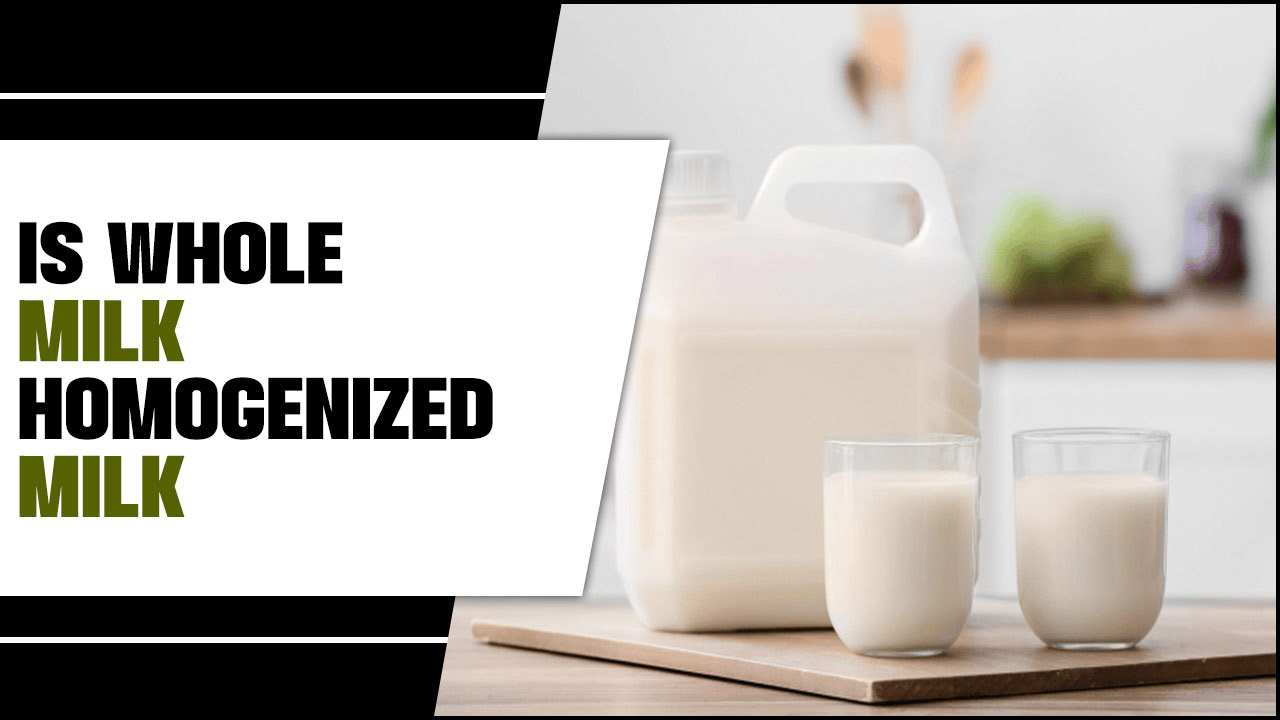Whole milk is milk that contains all the natural fat and nutrients that are found in milk. Is whole milk homogenized milk? Many people, especially those concerned about their health and the quality of the milk they consume, have asked this question.
Homogenization was first introduced in the early 1900s to improve milk’s shelf life and appearance. It is now a common process most dairy companies use to produce uniform milk in texture and appearance.
However, some people believe that homogenization alters the natural structure of milk and may affect its nutritional value. We will explore the differences between whole milk and homogenized milk. Also, we will look at the processes used to produce each type of milk and how those processes affect the final product.
We will also examine the nutritional value of both types of milk, including the fat content and other nutrients. Additionally, we will discuss the advantages and disadvantages of each type of milk and any potential risks or concerns associated with their consumption.

What Are Whole Milk And Homogenized Milk?

Whole milk and homogenized milk are both dairy milk types from cows. The main difference between the two is how they are processed. Whole milk comes straight from the cow and has no fat removed. It typically contains about 3.25% milkfat and is often sold in gallon or half-gallon containers. People often use whole milk in cooking, baking, and drinking.
Conversely, processors homogenize milk to distribute the fat particles evenly throughout the milk. This process involves forcing the milk through a fine filter to break up the fat particles and prevent them from separating.
Homogenized milk typically contains the same amount of milk fat as whole milk (about 3.25%), but it has a smoother texture and a creamier taste. Both whole and homogenized milk are good sources of calcium, vitamin D, and other important nutrients. However, if you are watching your fat intake, you may want to choose a lower-fat option, such as 2% or 1% milk.
The Nutritional Content Of Whole Milk And Homogenized Milk

Whole milk and homogenized milk are two types of dairy products that are popular in many households. Although both come from cows, their nutritional content and production process differ. Whole milk has not undergone any processing to remove the fat content. It typically contains around 3.25% fat, which makes it a high-fat dairy product.
It is also a good source of protein, calcium, and vitamin D. A cup of whole milk contains around 150 calories, 8 grams of fat, 8 grams of protein, and 30% of the recommended calcium intake.
Homogenized milk, on the other hand, undergoes a process that breaks down the fat globules so that they stay suspended in the milk. This results in a more uniform texture and prevents the cream from separating from the milk.
Homogenized milk also has a lower fat content than whole milk, typically around 2%. It has a similar nutritional profile to whole milk, with a cup of homogenized milk containing around 120 calories, 5 grams of fat, 8 grams of protein, and 30% of the daily recommended calcium intake.
In conclusion, while whole and homogenized milk have similar nutritional content, they differ in fat content and production process. Whole milk is higher in fat, while homogenized milk has a more uniform texture and a lower fat content. Both types of milk are good sources of protein, calcium, and vitamin D, which are important for maintaining a healthy diet.
Is Whole Milk Homogenized Milk – How Do They Compare?

The importance of choosing between whole milk and homogenized milk depends on personal preference and dietary needs. Whole milk is higher in fat and calories than homogenized milk, which may benefit individuals who need to gain weight or want to add richness to their dishes.
However, homogenized milk may be better for individuals who need to watch their fat intake or are trying to lose weight, as it contains less fat and calories. It is also important to note that homogenized milk has a longer shelf life than whole milk as it is less susceptible to spoilage due to the even distribution of fat molecules.
This may be important for individuals who do not consume milk frequently or for families who need to stock up on milk for longer periods of time. Here are explained about is whole milk homogenized milk.
The Fat Content Of Whole Milk
As the name suggests, whole milk contains the natural fat content present in raw milk. On average, it has approximately 3.25% fat. This higher fat content gives it a creamy and indulgent texture, making it a popular choice for many. The fat in whole milk provides a satisfying taste and essential nutrients.
It plays a crucial role in aiding the absorption of fat-soluble vitamins like A, D, E, and K. Additionally, the fat content in whole milk can benefit young children and individuals who need additional calories for growth or energy. However, skim or low-fat milk options are available for those looking to reduce fat intake.
The Fat Content Of Homogenized Milk
Homogenized milk also contains approximately 3.25% fat, just like whole milk. The key difference lies in its texture. The homogenization process breaks down the milk’s fat globules into smaller particles. Resulting in a smooth and consistent texture throughout. This process prevents cream separation and creates a uniform appearance.
Despite the change in texture, homogenized milk offers the same fat content as whole milk, providing a similar creamy taste and essential nutrients. Homogenized milk can be preferable for those who want a smoother mouthfeel without sacrificing the benefits of whole milk’s natural fats.
The Taste And Texture Of Whole Milk

Whole milk boasts a rich and full-bodied taste from its natural fat content. The higher fat content gives it a creamy texture, providing a more indulgent milk experience. You’ll notice its smoothness coating your palate as you sip whole milk.
The creaminess makes it a delightful beverage or an excellent addition to coffee, tea, cereals, and desserts. Due to its more pronounced flavour and texture, many people find whole milk more satisfying, especially when seeking a comforting and wholesome drink.
The Taste And Texture Of Homogenized Milk
Homogenized milk offers a taste similar to whole milk, but its texture sets it apart. The homogenization process breaks down the fat globules in milk, resulting in a smoother and more consistent texture. As you drink homogenized milk, you’ll notice its evenness and uniformity, devoid of any cream separation.
The taste is still creamy and enjoyable, making it a preferred choice for those who appreciate a consistent mouthfeel. Homogenized milk is versatile and can be handy in various culinary applications, providing a smooth and delightful experience.
The Shelf Life Of Whole Milk
Like many dairy products, whole milk has a relatively short shelf life. When properly refrigerated, it can typically last around 5-7 days. However, it’s essential to monitor the milk’s expiration date and store it at the correct temperature to maintain its freshness.
After the expiration date, the milk may start to sour and develop an unpleasant odour, rendering it unsuitable for consumption. To reduce waste and ensure the best taste, purchasing an amount that aligns with your household’s milk consumption is advisable.
The Shelf Life Of Homogenized Milk

Homogenized milk shares a similar shelf life with whole milk, lasting about 5-7 days when appropriately refrigerated. The homogenization process does not significantly affect the milk’s longevity. As with any dairy product, following proper storage guidelines is essential to preserve its freshness.
Checking the expiration date before consumption is crucial to guarantee the milk’s quality and taste. For households with consistent milk consumption, buying an appropriate quantity can help minimize wastage and ensure you enjoy the milk at its best.
The Health Benefits Of Whole Milk
Whole milk packs a nutritional punch, offering several health benefits. It is an excellent source of calcium, essential for maintaining strong bones and teeth. Additionally, whole milk provides vitamin D, crucial for calcium absorption and immune system support.
The fat content in whole milk supports brain health, as certain fatty acids are essential for cognitive function. For growing children and individuals with increased calorie needs, whole milk can be a valuable part of a balanced diet, helping to meet energy requirements and support growth and development.
The Health Benefits Of Homogenized Milk
Homogenized milk shares the same health benefits as whole milk, as it contains equal fat and nutrients. Like whole milk, homogenized milk is an excellent source of calcium and vitamin D, contributing to bone health and immune function.
It also provides essential proteins, necessary for building and repairing tissues throughout the body. The homogenization process does not alter the milk’s nutritional composition, making homogenized milk a wholesome and nutrient-rich choice for people of all ages.
Which One Should You Choose?

The decision between whole and homogenized milk depends on individual preferences and dietary needs. Whole milk is the better choice if you enjoy a richer taste and creamier texture. Its natural fat content provides a satisfying and indulgent experience, perfect for enjoying on its own or incorporating into various recipes.
On the other hand, homogenised milk is a suitable option if you prefer a smoother mouthfeel and milk that appears consistent throughout. Both types of milk offer essential nutrients like calcium, vitamin D, and protein, contributing to a balanced diet. It’s essential to consider personal taste preferences and dietary requirements when making a selection
Conclusion
It is clear that is whole milk homogenized milk is not the same thing. While whole milk is simply milk that has not had any fat removed, homogenized milk is milk that has been processed through a homogenizer to break up the fat particles and distribute them evenly throughout the milk.
This process provides a smoother texture and prevents the cream from separating. Not all milk is homogenized, as some people prefer the taste and texture of non-homogenized milk. It is important to note this.
However, it can be a great option for those who prefer homogenised milk. Ultimately, whether one consumes whole or homogenized milk depends on their preferences and dietary needs. To answer the question, no one homogenizes whole milk.
FAQs
1.Is Lactose-Free Milk The Same As Regular Milk?
Ans: No, lactose-free milk is treated to break down lactose, the natural sugar in milk, making it suitable for lactose-intolerant individuals. Regular milk contains lactose.
2.Is Almond Milk A Good Dairy Milk Substitute?
Ans: Almond milk is a popular dairy milk alternative for those who are lactose intolerant or prefer a plant-based option. It’s low in calories and contains no cholesterol.
3.Homogenized Milk Is What?
Ans: Homogenized milk is a type of milk that has undergone a mechanical process to break down the fat globules, distributing them evenly throughout the milk to prevent cream separation.
4.How Does Homogenization Affect The Taste Of Milk?
Ans: Homogenization doesn’t significantly alter the taste of milk. Its purpose is to create a consistent texture and prevent the cream from rising to the top, maintaining a uniform taste.
5.Is Homogenized Milk Healthier Than Non-Homogenized Milk?
Ans: The nutritional content of homogenized and non-homogenized milk remains the same. The main difference lies in the texture, as homogenized milk is smoother and creamier.
